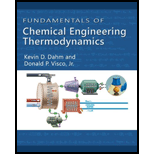
(A)
Interpretation:
The heat added to the gas.
Concept Introduction:
The analogous time-independent form of energy balance for the gas is written as:
Here, time is
(A)
Explanation of Solution
The analogous time-independent form of energy balance for the gas is written as:
Neglecting the potential and kinetic energy for a closed system with no shaft work and no expansion work, equation (1) can be rewritten as:
Here, number of moles is
The equation for the change in internal energy
Here, molar internal energy at state 2 is
To calculate the residual molar internal energy
Here, molar volume is
Partially differentiate the Van der Waals equation to obtain
Here, gas constant is
Substitute
The expression for the change in internal energy
Here, constant volume heat capacity for ideal gas is
Substitute
Substitute
Calculate the change in molar internal energy
Substitute
Substitute
The heat added to the gas is
(B)
Interpretation:
The heat added to the container.
(B)
Explanation of Solution
Rewriting Equation (2):
Here, mass is
Substitute
The heat added to the container is
(C)
Interpretation:
The change in entropy of the gas.
Concept Introduction:
The residual entropy
Here, molar volume is
(C)
Explanation of Solution
The equation for the change in entropy
Here, molar entropy at state 2 is
The residual entropy
Partially differentiate Van der Waals equation to find
Here, gas constant is
Substitute
Using Van der Waals expression, calculate the initial volume
Here, initial pressure is
Substitute
The number of moles and volume remains constant so this value will also apply at final state. Therefore, the final volume is
The final pressure
Substitute
Write the expression of the parameter
Here, constant volume heat capacity for ideal gas is
Substitute
The change in molar entropy
Substitute
The change in entropy
Substitute
Hence, the change in entropy
(D)
Interpretation:
The change in entropy of the universe.
Concept Introduction:
The formula to calculate the change in entropy of the universe
Here, change in entropy of the gas is
Write the expression of the change in entropy of the container
Here, change in reversible heat is
(D)
Explanation of Solution
The formula to calculate the change in entropy of the universe
Write the expression of the change in entropy of the container
Substitute
Integrating Equation (11), we get,
Here, mass is
Substitute
Assuming the furnace as a heat reservoir, calculate the change in entropy of the furnace
Here, heat added or removed from furnace is
The heat added or removed from furnace
Here, heat added or removed from gas and container is
Substitute
Substitute
Substitute
The change in entropy of the universe
(E)
Interpretation:
What aspect of this process is irreversible?
(E)
Explanation of Solution
The large variation between the initial and final temperature is the irreversible aspect of this process.
Want to see more full solutions like this?
Chapter 6 Solutions
Fundamentals of Chemical Engineering Thermodynamics (MindTap Course List)
 Introduction to Chemical Engineering Thermodynami...Chemical EngineeringISBN:9781259696527Author:J.M. Smith Termodinamica en ingenieria quimica, Hendrick C Van Ness, Michael Abbott, Mark SwihartPublisher:McGraw-Hill Education
Introduction to Chemical Engineering Thermodynami...Chemical EngineeringISBN:9781259696527Author:J.M. Smith Termodinamica en ingenieria quimica, Hendrick C Van Ness, Michael Abbott, Mark SwihartPublisher:McGraw-Hill Education Elementary Principles of Chemical Processes, Bind...Chemical EngineeringISBN:9781118431221Author:Richard M. Felder, Ronald W. Rousseau, Lisa G. BullardPublisher:WILEY
Elementary Principles of Chemical Processes, Bind...Chemical EngineeringISBN:9781118431221Author:Richard M. Felder, Ronald W. Rousseau, Lisa G. BullardPublisher:WILEY Elements of Chemical Reaction Engineering (5th Ed...Chemical EngineeringISBN:9780133887518Author:H. Scott FoglerPublisher:Prentice Hall
Elements of Chemical Reaction Engineering (5th Ed...Chemical EngineeringISBN:9780133887518Author:H. Scott FoglerPublisher:Prentice Hall
 Industrial Plastics: Theory and ApplicationsChemical EngineeringISBN:9781285061238Author:Lokensgard, ErikPublisher:Delmar Cengage Learning
Industrial Plastics: Theory and ApplicationsChemical EngineeringISBN:9781285061238Author:Lokensgard, ErikPublisher:Delmar Cengage Learning Unit Operations of Chemical EngineeringChemical EngineeringISBN:9780072848236Author:Warren McCabe, Julian C. Smith, Peter HarriottPublisher:McGraw-Hill Companies, The
Unit Operations of Chemical EngineeringChemical EngineeringISBN:9780072848236Author:Warren McCabe, Julian C. Smith, Peter HarriottPublisher:McGraw-Hill Companies, The





